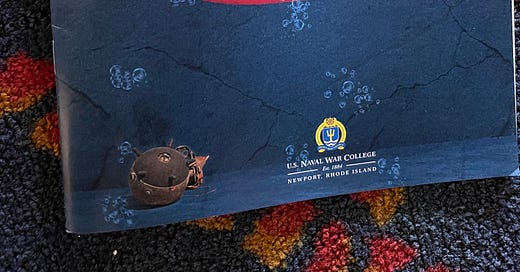the value of open source and classified
we should not ignore open source sources in our discussions of the PLAN
Retirement from formal office hours allows me to attend conferences for the first time in fifteen years as I am no longer tied to quite the same schedule. In particular, I get to hear many of the China conversations I alone could read for decades. The advantages of being here is side conversations not captured in papers subsequently published.
The Chinese Military Studies Institute in Newport, Rhode Island is hosting a conference this week on Chinese undersea warfare. About 170 folks are listening to updates on what the People’s Liberation Army Navy is deploying these days. The sessions are completely unclassified, reminding us that much information is available online on pretty technical military topics in the Middle Kingdom, Russia, and elsewhere.
Much of the conversation centers on PLAN hardware developments. Submarines, obviously the heart of undersea activity, are less familiar to the public than aircraft carriers, the latter of which Beijing has been showing off over the past decade after their initial purchase of an old Ukrainian carrier hit the news.
I don’t claim to understand the specifics of some of the technical updates. I am not a submariner nor a Naval officer nor even someone who wore a uniform. I am a retired civilian academic but I can hear the debates across the panels. I note some audience gasps following occasional comments while other listening shake their heads as analysts provide comments on hull pressure or speeds of the craft.
The panel I am most interested in revolves around the personnel in undersea warfare as the heart of militaries around the world is the folks who operate (the preferred verb remains ‘mans’) the fleet. We haven’t reached that yet.
I am gratified we still have a range of views expressed across these panels. We heard a few people skeptical that we might be giving the PLAN too much credit for ‘achievement’ versus ‘aspiration’ of some of their programs, but that ought not surprise us. Militaries, by design, prepare for the worst thus they tend to see most programs as fully functional and successful if a system is proposed or funded by any government. The United States is not unique; I have heard Asian officers discuss deployed technologies the U.S. Navy only have mentioned wistfully as the technologies remain on the white board.
The Chinese are also sure all of our systems are fully operational and work perfectly. This is a major reason they will never accept that the 5 May 1999 missile that hit their embassy in Belgrade as the U.S. Air Force using an obsolete map.
Striking, and more relevant, is how much about Chinese undersea efforts remains unclassified. I prefer being able to interact with average citizens rather than ‘cleared’ populations so I rarely touched anything classified over 30 years. We teach U.S. and international officers at the National War College so we only used open-source materials.
My first year, a former Soviet bloc officer was absolutely certain we had two different curricula for American and foreign students. Uh, no. (He obviously had no idea how much effort it takes to craft a curriculum in any language. The idea of two or more would have broken our capacity to keep up-to-date on the changing world). At one evening function, following a few drinks, he accosted U.S. colleagues to demand seeing the real curriculum since this guy’s country was about to join NATO. Nope, he was the one out of the loop for a different reason than he realised.
.
We did actually have one single Russian officer in all my years at National. It was 1993-94, my first year as core course director for our Geostrategic Context course. He happened to be in my seminar and, as you would expect considering how close this was to the end of both the Cold War and the Soviet Union, that we were not showing him everything. We used then and use now unclassified material because the questions we consider are really answerable without going into classified material. Yes, there are a couple of classified elective courses but, as of now, when we invite people to National’s core curriculum, we want them participating fully. Open source articles from journaux and news sources rule.
What we need recall is how much material is now publicly available via google. (No, I am not talking about the current classified document mess at the Pentagon on Russia and Ukraine. I have no idea who leaked that information nor why. It is a gross violation of the oaths those individual(s) took upon receiving a clearance but that material in the news today is not google-generated material). Perfectly legal commercial venues selling satellite-provided information must also exist in great numbers in the United States and Europe, though that is speculation based on the power of the free market. I imagine if one has sufficient cash, the subscriptions for these public data must be vast.
So many overhead photographs, however, are straight out of commercial, public views. The spread of these technologies because of their reduced costs over the past twenty years, the proliferation of vendors to share these photographs, and the capability to launch satellites is vastly greater than at the turn of the millenium.
Similarly, the number of people who now read Chinese is considerably greater than twenty-five years back when Mandarin was, in the views of a long-time watcher, the Middle Kingdom’s ‘first wall of protection’. Chinese believed we would not bother learning the languages, could not master it, or were too lazy to absorb.
If that were ever true, no longer. Mandarin remains the purview of a small number in the United States but an ever greater percentage of folks who can use the language in analysing these technologies and political questions.
By the way, we need more Mandarin (and Farsi and Russian and every other language I can name) speakers because we still ignore the rest of the world—96% of the population—at our peril but that is another topic.
Artificial Intelligence (AI) translation programs in 2023 are infinitely more precise than they were as PLA modernisation began in the mid-1990s. To say the translations were poor and clunky in the ‘90s understates how bad much of it was. Computers still don’t get all nuance of the Mandarin-to-Chinese translations but they are markedly improved and sophisticated. These translation systems provide unclassified, public source assistance to so many following the PLAN inside and outside of the governments around the world.
I am unconvinced that AI translation gets to the most subtle differences in language—hence I like introducing human speakers—but they most definitely provide much better translations that a generation ago. And they flat out provide unclassified access to many things we found more exotic decades ago.
Unclassified information, of course, is no guarantee we know what Xi Jinping or his GOFOs (General Officers/Flag Officers) intend with their improved technology. As I have argued, we don’t have clarity on what Xi aspires towards because we don’t have access to the closed circle operating around him. No matter what someone tells me about China’s secret plans, I have severe questions how reliable any of that information is since we know Xi is increasingly skeptical about outsiders penetrating China’s walls. He doesn’t even trust his own people so why would we assume we can figure out his ultimate goals?
Analyses of intent are hard as any decision-making in any and all governments is complex. We cannot ignore that truth.
What we can do is regularly and iteratively continue studying these developments as we would study data coming in from any data collection. We need apply our analytical skills, as specialists and as analysts, to understand and perhaps project China’s future activities. For all the money we spend on intelligence community activities, we don’t gain certainty so we should stop assuming we do. Supplanting analysis for desired outcomes is far more comforting for me. But it is a hard slog as so many want to jump to the end, almost invariably the worst case scenario, before they have evidence to support that conclusion. What would it take to change that?
The sources of the data cannot substitute for smart analyses. Neither the best data nor the best analyses need complement each other but cannot guarantee outcomes because humans are the heart of these interactions.FIN






